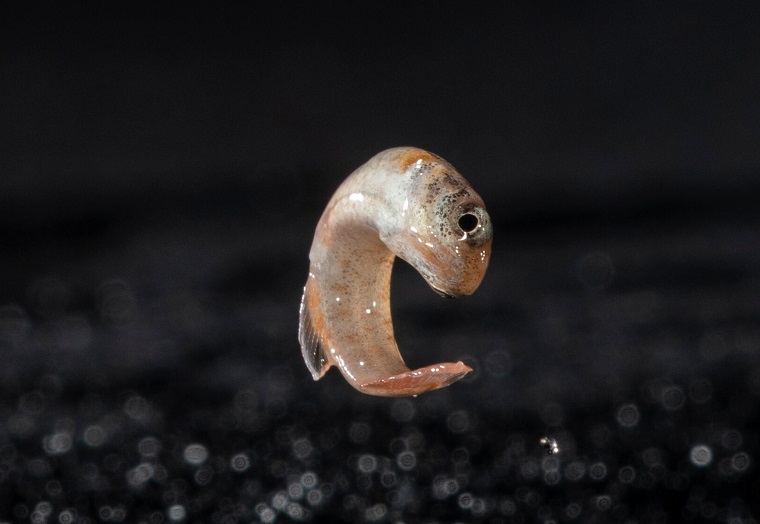A Tale of Two Worlds: Emersion and Exploration Behavior in an Amphibious Fish
By Michael Lim
6 December 2019

Mankind has always been curious about exploring the Earth’s oceans. While many scientists are focused on developing new methods to better explore the deep blue, researchers in the Department of Integrative Biology are more interested in what drives some sea dwelling animals to venture onto land. To answer this question, Profs. Patricia Wright and Frédéric Laberge, along with undergraduate researcher Irene Yin-Liao, turned their attention to a small amphibious fish known as the mangrove rivulus.
The mangrove rivulus is native to Central and South America, where it experiences dramatic changes in its environment between the wet and dry seasons. As the coastal marine and brackish water bodies it inhabits shrink during the dry season, the mangrove rivulus can be exposed to lower dissolved oxygen levels, increased salinity, and greater competition for space and resources. To escape these stressful situations and seek out new habitats, the mangrove rivulus has developed the ability to leave, or emerse, from water onto land.
Manoeuvring on land as a fish is no small challenge. It requires a lot more energy compared to being in water, where the fish is naturally buoyant and mobile. Although the mangrove rivulus can survive extended periods of time on land, being able to efficiently explore its surroundings on land could help the fish find better habitats more quickly. But what a mangrove rivulus actually does when it leaves water is a bit of a mystery – little is known about its behavior on land, or even in water.
That is where Yin-Liao entered the picture.
As a student volunteer in the Wright and Laberge labs, Yin-Liao found herself wondering what conditions would trigger emersion and how exploration differed when fish were placed in an aquatic or a terrestrial environment.
“Exploration behavior is a really interesting study topic,” says Yin-Liao. “With so few studies in amphibious fish, we had a lot of interesting questions that we wanted to answer. Sometimes the answers weren’t what we expected, but that’s the fun part.”
In lab experiments, Yin-Liao first tested if she could trigger emersion onto land from an aquatic refuge by altering the water depth, salt concentration or level of crowding in the refuge. Reducing the water depth to 1 cm and increasing the level of crowding both led to faster, and more frequent, emersion by the fish. In contrast, increasing the salinity of the water (even as much as four times the control level) had no effect, suggesting that high salt levels may be relatively easy for the mangrove rivulus to cope with compared to other stressors.
Yin-Liao then examined the fish’s exploration behavior in different environments by placing three novel objects in a test area that was either “aquatic” (completely submersed in water), “terrestrial
(a damp platform with no standing water), or “semi-terrestrial” (containing a mere 2 mm of water above a platform). By timing how long it took the fish to visit the objects, she could identify how well the fish was able to explore novel objects in each type of environment.
The results were clear. Despite the semi-terrestrial environment allowing for easier movement by fish compared to the waterless terrestrial environment, the fish exhibited significantly less exploratory behavior in both test areas compared to the aquatic environment. In fact, it took nearly eight times longer for the mangrove rivulus to investigate all three objects in these environments compared to the aquatic test area.
Although other factors such as sensory constraints (for example, reduced vision in air) may have factored into the results, Yin-Liao is confident that there are clear differences in emersion and exploratory behaviour when on land versus in water. Part of this confidence may stem from the unique characteristics of the strain of fish she studied.
Unlike many species of fish, the mangrove rivulus possesses the sexual characteristics of both males and females, which eliminates sex-based differences seen in most species. Additionally, the mangrove rivulus is particularly exceptional as it is one of only two known vertebrate species that can self-fertilize. This means that when raised in isolation, they can produce offspring that are essentially genetically identical. After several generations, this results in an isogenic strain, like the one used in Yin-Liao’s study. By using individuals with essentially identical genes, the researchers could test individual physical and personality differences, rather than those that arise from random genetic differences.
“I really liked working with the mangrove rivulus; they present an interesting model,” says Yin-Liao. “As an isogenic strain of a hermaphroditic species, they take away several confounding factors making it easier to tease apart differences between treatments in a study.”
Yin-Liao, who is currently pursuing a Master’s degree in Integrative Biology on the effects of pollution on stress in fish, is hopeful that her undergraduate study will serve as the foundation for further work on emersion, exploration, and learning behaviour in other amphibious species.
“The unique ability of amphibious animals to inhabit different types of environments makes them fascinating organisms to study from a physiological, evolutionary, and behavioural standpoint,” notes Yin-Liao.
Funding for this research was provided by the Natural Sciences and Engineering Research Council.
Read the full article in the Journal of Fish Biology.
Read about other CBS Research Highlights.